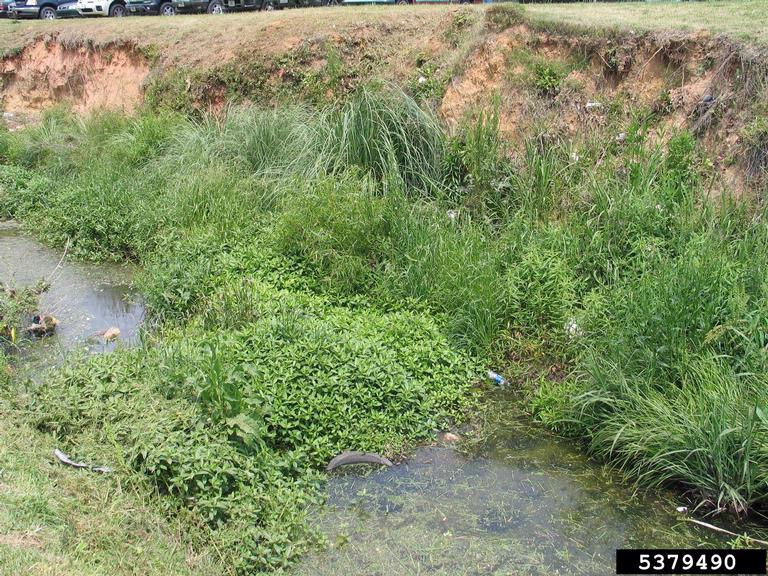Alternanthera philoxeroides
Alligator weed
Synonym(s): Achyranthes philoxeroides
Order: Caryophyllales
Family: Amaranthaceae
Duration and Habit: Perennial Herb

Photographer: USDA, ARS Archives
Source: www.forestryimages.org
Description
Alligator weed is most commonly found spread across the surface of a body of water described in a sprawling fashion. It can be found in terrestrial areas around gardens or in between rows of crops with sufficient moisture present. Stems are pink and hollow and can reach lengths of 1 m with opposite narrow elliptical leaves. Flowers are reduced and white in color, have thin petals, and are on stems that extend 4-5 inches away from the plant.
Ecological Threat: Alligator weed grows in thick dense mats along the shoreline of lakes and streams creating difficulty for wildlife to access the edge of the water. Alligator weed doesn't provide a sufficient food source or shelter for aquatic wildlife. By preventing native plants from growing, alligator weed removes necessary food sources and shelter for native animals.
Biology & Spread: Alligator weed is able to spread and reproduce rapidly through stems or leaf cuttings making it difficult to eradicate in areas once established because it can grow from small portions of the plant left behind. Alligator weed propagates most commonly from stolons vegatatively with each individual node capable of propagating allowing for rapid spread and propagation of the plant.
History: Alligator grass originated in South America, but was transferred to the United States through water ways accidentally. The exact date when the weed was transferred to the United States is not known. It became noticeable on a pest status in 1959 when the U.S. Army Corps of Engineers investigated the damage potential caused by propagation of alligator weed. Investigation into damage potential of alligator weed resulted in placement on the federally noxious weed list for several states preventing further propagation and distribution.
U.S. Habitat: Alligator weed can grow in a variety of habitats from dry to immersed in water, but the preferred habitat is aquatic. In the United States alligator weed is most often found growing along the surface of streams and ponds at the shores edge.
Distribution
Native Origin: South America
U.S. Present: Alligator weed is found in the southwest United States from San Joaquin Valley south to Los Angeles and across the south and east portions of the continent south to Central America.
Management
Physical removal of alligator weed is possible, but not usually 100% successful in eradicating the weed because the plant is able to re-grow and propagate from stem fragments alone. There are currently no biological control methods of eradication rather than goats which can keep the plant under control by feeding on the weed. Chemical control has been found to be the most successful when containing fluridone or imazapyr. Other chemical treatments have been found slightly less successful, but still effective when containing: 2,4-D, glyphosate, triclopyr, and imazamox. Systematic herbicides such as Navigate and Weedar 64 are successful chemical treatments as well.
Text References
Andres, L. A. 1977. The economics of biological control of weeds. Aquatic Botany 3: 111-123.
Internet Sources
www.itis.gov
 Texas Invasive Species Institute
Texas Invasive Species Institute